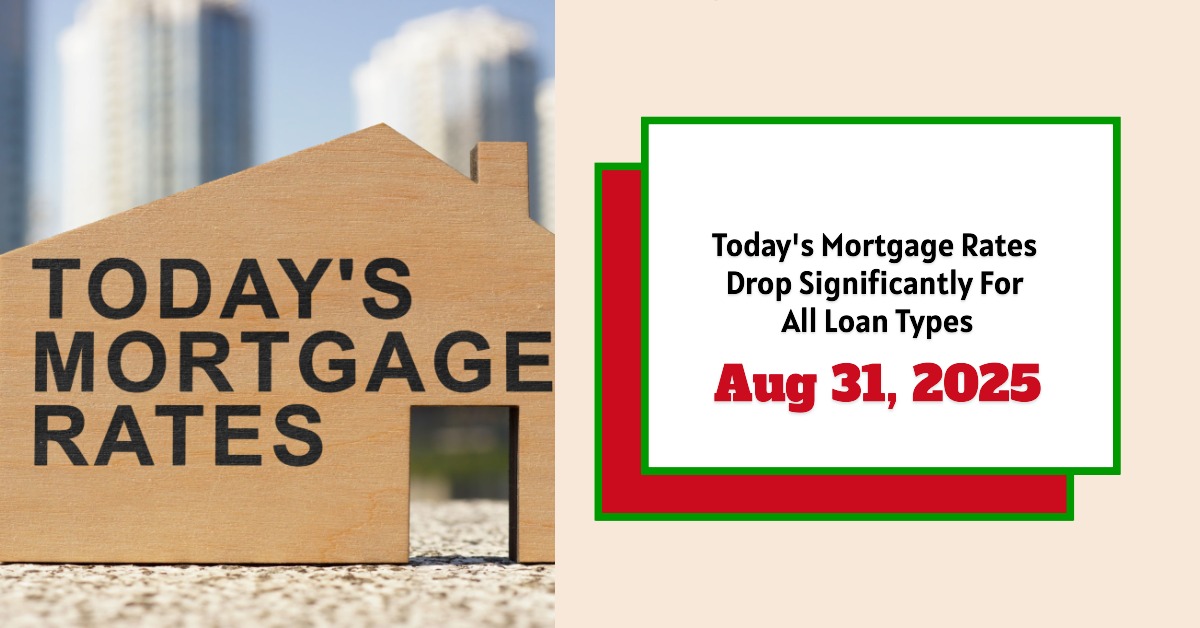As of August 31, 2025, mortgage rates have dropped notably across nearly all loan types, with the 30-year fixed mortgage rate declining to 6.57%, a 10 basis points (0.10%) decrease from last week’s 6.67% average (Zillow). Refinancing rates also saw declines, with the 30-year fixed refinance rate falling to 6.79%. This trend marks the lowest mortgage rates in ten months, driven largely by expectations of an upcoming Federal Reserve interest rate cut and weakening job growth, which have kept borrowing costs on a downward path. This shift could mean more affordable options for homebuyers and those seeking to refinance in the near future.
Mortgage Rates Today – August 31, 2025: Rates Drop Significantly For All Loan Types
Key Takeaways:
- 30-year fixed mortgage rate dropped to 6.57% from 6.67% last week, the lowest in ten months.
- 15-year fixed mortgage rate also declined, now averaging 5.51%.
- 5-year ARM rates decreased to 6.73%.
- Refinance rates dropped, with 30-year fixed refinance rates falling to 6.79%.
- Economic data signals a high probability (around 91%) of a Fed rate cut in September, which could further reduce mortgage rates.
- Experts predict mortgage rates to remain above 6% throughout 2025 and gradually drop in 2026, with forecasts placing the 30-year fixed rate near 6.4% by year-end.
- This decline comes amid cooling inflation, weaker job growth, and anticipated Federal Reserve easing.
Current Mortgage Rates by Loan Type (August 31, 2025)
The table below summarizes the key mortgage rates, showing weekly changes for conforming and government-backed loans — including fixed-rate and adjustable-rate mortgages (ARMs).
| Loan Type | Current Rate | Weekly Change | APR | APR Weekly Change |
|---|---|---|---|---|
| Conforming Loans | ||||
| 30-Year Fixed | 6.57% | -0.10% | 6.82% | -0.29% |
| 20-Year Fixed | 6.31% | -0.12% | 6.71% | -0.21% |
| 15-Year Fixed | 5.51% | -0.26% | 5.67% | -0.40% |
| 10-Year Fixed | 5.79% | 0.00% | 6.09% | 0.00% |
| 7-Year ARM | 7.04% | -0.15% | 7.70% | -0.04% |
| 5-Year ARM | 6.73% | -0.40% | 7.30% | -0.43% |
| Government Loans | ||||
| 30-Year Fixed FHA | 6.25% | +0.23% | 7.27% | +0.24% |
| 30-Year Fixed VA | 6.31% | +0.11% | 6.53% | +0.10% |
| 15-Year Fixed FHA | 5.44% | -0.11% | 6.40% | -0.12% |
| 15-Year Fixed VA | 5.96% | +0.12% | 6.32% | +0.12% |
Current Refinance Rates (August 31, 2025)
Refinance rates have also shown favorable movement this week, promising potential savings for homeowners looking to lower their mortgage payments.
| Loan Type | Current Rate | Weekly Change |
|---|---|---|
| 30-Year Fixed | 6.79% | -0.08% |
| 15-Year Fixed | 5.58% | -0.05% |
| 5-Year ARM | 7.22% | +0.02% |
(Source: Zillow, August 31, 2025)
Understanding This Week's Rate Movements
Mortgage rates today reflect a complex interplay of economic factors:
- Weaker Labor Market: The U.S. job growth slowed in early August, and unemployment rose to 4.2%. This softening labor market reduces pressure on the Federal Reserve to raise interest rates aggressively.
- Inflation Pressure Cooling: Inflation metrics, such as the Consumer Price Index (CPI) and the Core Personal Consumption Expenditures (PCE) index, have eased but remain above the Fed’s ideal target, sustaining cautious optimism.
- Market Expectations of Fed Action: Traders assign over a 90% chance that the Fed will cut interest rates by 0.25% at their next meeting on September 16-17, signaling expectations for looser monetary policy.
- Bond Market Indicators: The 10-year Treasury yield, closely tied to mortgage rates, has dropped to about 4.23%, which helps push mortgage costs lower.
- Mortgage Rate Volatility: While rates have fallen this week, they remain volatile, especially with mixed signals about inflation and economic recovery.
The Fed's expected rate cut is pivotal. Past monetary policy decisions have a direct and sometimes delayed impact on mortgage rates, influencing home affordability and borrowing decisions.
How This Affects Homebuyers and Refinancers
For a borrower looking at a $300,000 loan amount, here’s a comparison of monthly principal and interest payments based on recent versus current rates:
| Term | Rate (Last Week) | Rate (Now) | Monthly Payment Last Week | Monthly Payment Now | Savings Per Month |
|---|---|---|---|---|---|
| 30-Year Fixed | 6.67% | 6.57% | $1,933 | $1,898 | $35 |
| 15-Year Fixed | 5.63% | 5.51% | $2,448 | $2,416 | $32 |
Calculation based on a $300,000 loan at fixed rates.
Even a small decline in rates can translate into significant monthly savings, especially over the life of the mortgage. For homeowners considering refinancing, these improved rates can lower monthly payments or reduce the loan term.
Forecast for Mortgage Rates: What Experts Say
Several key organizations provide forecasts that help shape expectations for the mortgage market:
- National Association of REALTORS® anticipates mortgage rates averaging 6.4% in the second half of 2025, potentially decreasing to about 6.1% in 2026. They emphasize how much rates drive buyer affordability and market demand.
- Realtor.com echoes a gentle easing of rates, suggesting that by the end of 2025, averages could dip to approximately 6.4%, closely matching rates from the previous year.
- Fannie Mae’s August 2025 forecast projects mortgage rates ending 2025 at 6.5%, and further dropping to 6.1% by the end of 2026. Mortgage originations are forecasted to rise accordingly, reaching approximately $1.85 trillion in 2025.
- Mortgage Bankers Association expects a 30-year mortgage rate of 6.7% at the end of 2025, declining to 6.5% by year-end 2026, citing ongoing volatility in mortgage-Treasury spreads.
These predictions illustrate a consensus that while rates have fallen recently, they are unlikely to dip below 6% for much of this year, with modest improvements anticipated across 2026.
The Federal Reserve’s Influence on Mortgage Rates
The Federal Reserve’s monetary policy remains the central force behind mortgage rate trends:
- From 2021 through mid-2023, the Fed’s aggressive interest rate hikes pushed mortgage rates to 20-year highs.
- Late 2024 saw the Fed pivoting towards rate cuts, lowering the federal funds rate by 1 percentage point across three reductions.
- In 2025, the Fed has paused rates but is widely expected to cut again in September amid signs of economic slowdown.
- The Fed’s decisions impact Treasury yields, which underpin mortgage rates; a cut typically leads to lower mortgage borrowing costs.
- Market pricing currently indicates an 85-95% probability of a September cut, backed by softening inflation and a cooling labor market.
A key Fed meeting on September 16-17 is eagerly awaited by markets and homebuyers alike, as its outcome could confirm the trend of declining mortgage rates. However, any unexpected persistence in inflation or economic resilience might keep rates elevated longer.
Related Topics:
Mortgage Rates Trends as of August 30, 2025
Mortgage Rates Predictions Next 90 Days: August to October 2025
Mortgage Rate Trends Overview: A Summary
- Mortgage rates, after tightening for much of 2023 and early 2025, are now easing.
- The primary driver for this recent drop is widespread market expectation of a Fed interest rate cut.
- Despite improvements, mortgage rates remain elevated compared to historical lows, hovering just above 6% for 30-year fixed loans.
- For most borrowers, this means paying cautious attention to market developments without waiting endlessly for a “perfect” rate.
- Refinance activity may rise as rates dip below 7%, but volatility means refinancing opportunities could be fleeting.
In-Depth Look: Market and Economic Data Shaping Rates
- Job Growth & Unemployment: The August 2025 jobs report showed slower growth, with unemployment climbing slightly to 4.2%. This signals to the Fed that economic activity is cooling, supporting rate cuts.
- Inflation Metrics: Although inflation has moderated, the Core Personal Consumption Expenditures (PCE) index remains around 2.7%, still above some target levels, complicating the Fed’s decisions.
- Treasury Yields: The 10-year Treasury yield is a key indicator for mortgage rates and has recently fallen to about 4.23%. This decline helps reduce mortgage borrowing costs.
- Yield Curve Behavior: After a period of inversion (short-term yields higher than long-term), the yield curve is normalizing, hinting at more stable economic expectations.
These economic signals place mortgage rates in a dynamic position, influenced heavily by external macroeconomic factors and monetary policy.
Capitalize Amid Rising Mortgage Rates
With mortgage rates expected to remain high in 2025, it’s more important than ever to focus on strategic real estate investments that offer stability and passive income.
Norada delivers turnkey rental properties in resilient markets—helping you build steady cash flow and protect your wealth from borrowing cost volatility.
HOT NEW LISTINGS JUST ADDED!
Speak with a seasoned Norada investment counselor today (No Obligation):
(800) 611‑3060
Also Read:
- Will Mortgage Rates Go Down in 2025: Morgan Stanley's Forecast
- Mortgage Rate Predictions 2025 from 4 Leading Housing Experts
- Mortgage Rate Predictions for the Next 3 Years: 2026, 2027, 2028
- 30-Year Fixed Mortgage Rate Forecast for the Next 5 Years
- 15-Year Fixed Mortgage Rate Predictions for Next 5 Years: 2025-2029
- Will Mortgage Rates Ever Be 3% Again in the Future?
- Mortgage Rates Predictions for Next 2 Years
- Mortgage Rate Predictions for Next 5 Years
- Mortgage Rate Predictions: Why 2% and 3% Rates are Out of Reach
- How Lower Mortgage Rates Can Save You Thousands?
- How to Get a Low Mortgage Interest Rate?
- Will Mortgage Rates Ever Be 4% Again?



